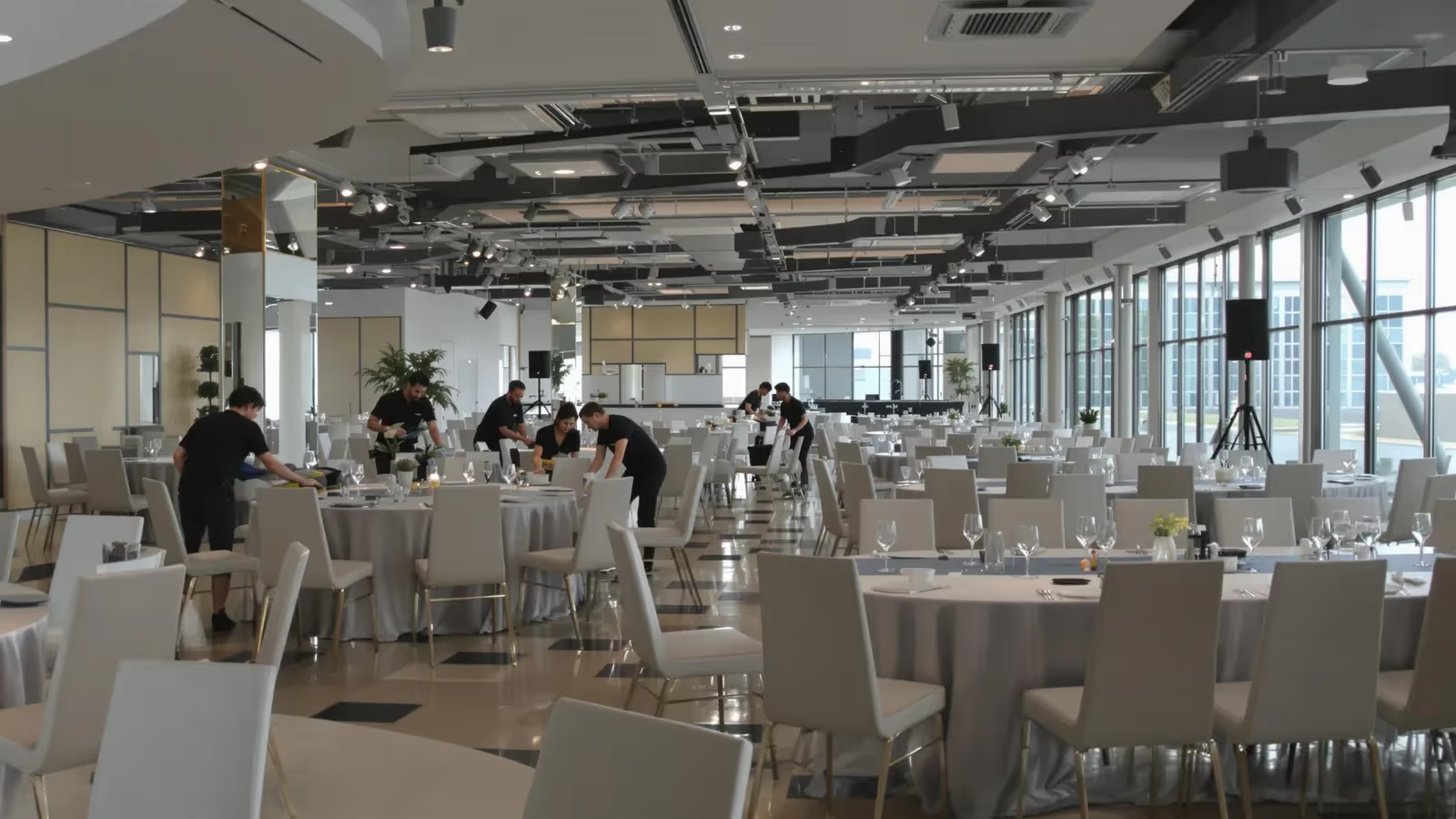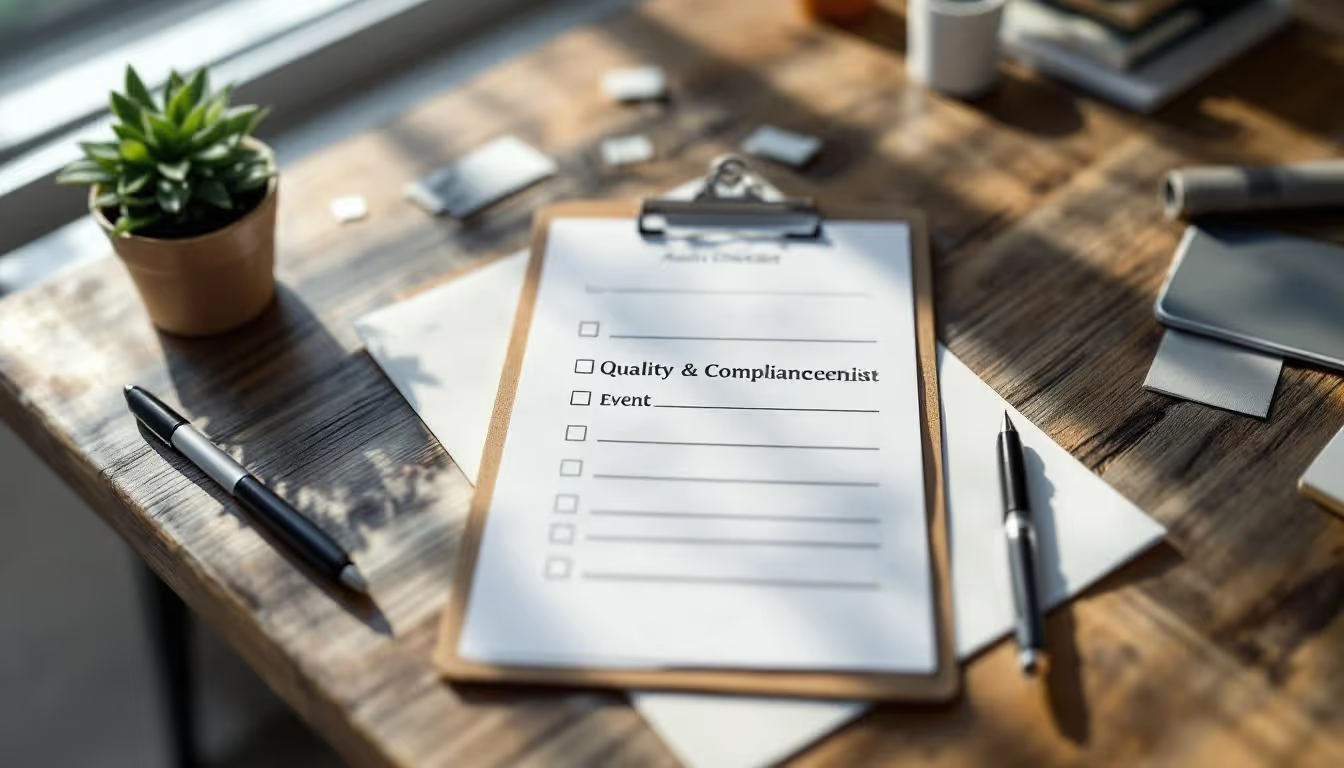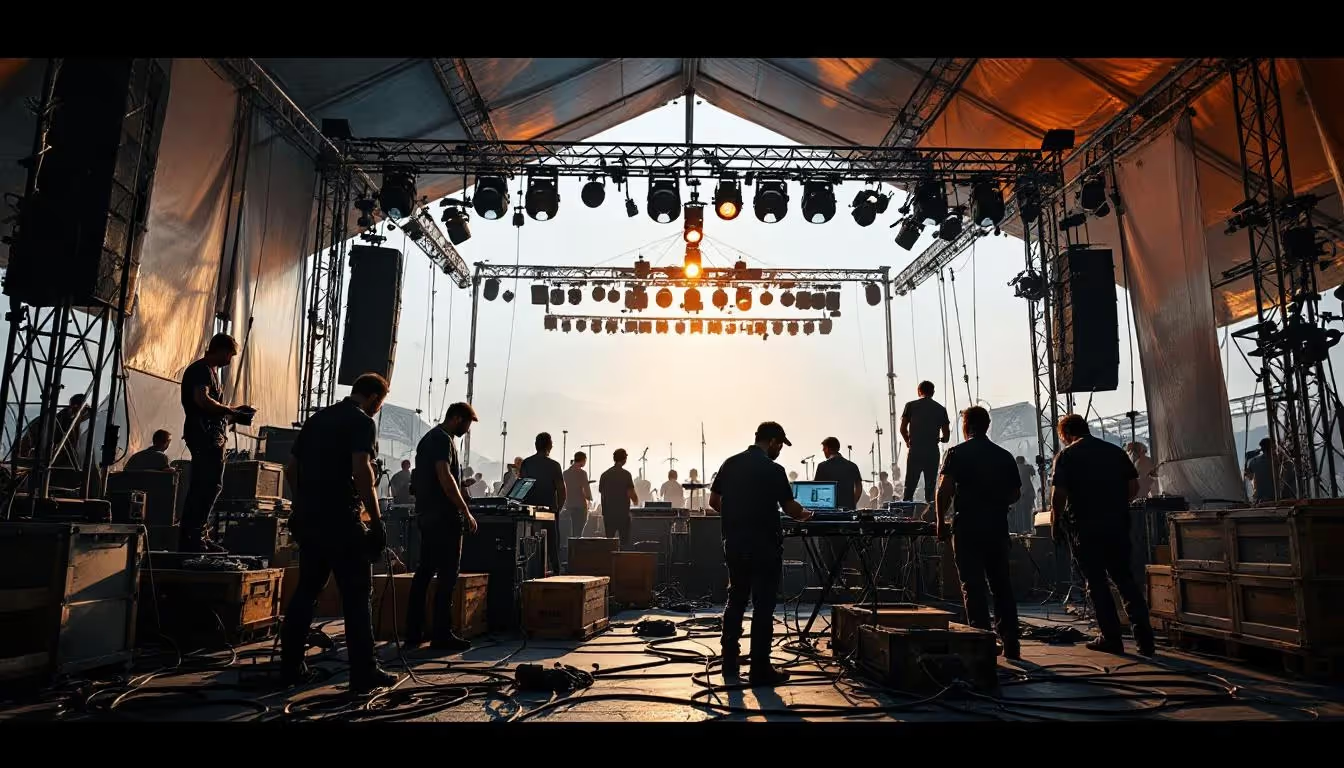Event organization may seem simple from the outside, but there's a whole world of preparation and coordination going on behind the scenes to ensure success.
Because behind the scenes of a corporate event lies a great deal of meticulous planning, our agency invites you to discover the secrets that make the difference between a successful evening and a failure.
You'll see how event professionals orchestrate every step of the way, from initial meetings to welcoming guests on the big day.
Behind the scenes of event organization
Invisible preparation for major events
Behind every successful event lies a mountain of preparatory work that nobody sees.
Preparing a corporate event usually begins several months in advance. We define the objectives and the target audience before looking for the perfect venue. Then we contact the various service providers for catering, technical services and entertainment. The budget is closely monitored to avoid overspending.
This meticulous preparation makes all the difference between an ordinary event and a memorable experience for guests.
Key players behind the scenes
A successful business event relies on a multi-skilled team working behind the scenes.
The event project manager coordinates the whole process and liaises with the customer. The technical teams take care of sound, lighting and scenography, transforming an empty space into a place of experience.
External service providers bring their specific know-how, from the caterer who treats guests to the DJ who hosts the evening.
The expertise of an event management agency in Paris is a major asset for the success of your projects.
For a successful event, you need a variety of skills.
- Technical manager: Ensures the smooth running of equipment.
- Logistics coordinator: Manages the flow of people and materials.
- Safety Officer: Ensuring a safe environment for all.
- Graphic designer: Creates the visual supports for the event.
A close-knit team is the key to a successful event.
Strategic event planning
Good planning is the foundation on which any event is built.
Planning a corporate event is a bit like putting together a jigsaw puzzle. You start by defining the date and objectives of the event. Then you create a back-plan, detailing all the actions to be carried out and their deadlines. Budget management is done in parallel, as it influences every decision.
To find out more about the various stages of organization, read our article on how to organize a successful corporate event.
Each type of event requires a specific approach to planning.
Logistics challenges and solutions
Organizing a corporate event always poses logistical challenges. Between venue constraints, tight deadlines and special customer requests, you need to be creative.
Late deliveries and last-minute cancellations are classic situations to which teams have to adapt quickly.
Faced with these challenges, organizers develop tailor-made solutions. A plan B is always in place for important elements such as the venue or key players. Project management tools enable real-time monitoring of the progress of preparations.
We also build strong relationships with several suppliers to have alternatives if one of them fails.
The experience we've built up over the course of our event projects means we can anticipate problems before they arise.
Resource and team management
Setting up and managing an events team
A successful corporate event starts with building a team with the right skills.
The team is generally put together according to the specific needs of the event project. For a seminar or a company party, different profiles are needed.
My advice is to first identify the key skills needed for each stage, and then find the right people to match them.
The size of the team needs to be adapted to the scale of the event - too small and you'll be overwhelmed, too big and it'll complicate coordination.
The success of an event depends very much on the motivation of the teams, who often work under pressure.
Budget and service provider management
Budget management is a critical point for any event project, especially when organizing business events or team building.
To manage an event's budget properly, you first need to accurately assess all expenditure items (hall rental, catering, entertainment, technical). The selection of service providers should be made after comparing several quotes, taking into account their experience and references.
I recommend a 10-15% margin for the unexpected, which always happens. Setting upbudget tracking tools gives you a clear view of expenses in real time, to avoid unpleasant surprises.
Technological tools at the service of events
New technologies have really changed the way we organize events and manage teams.
We now use lots of tools that make event planning and organization easier. Project management software such as Asana or Trello are great for keeping track of tasks and planning. Online registration platforms make it much easier to manage participants.
Event applications let guests access the program and practical information directly on their phone. The expertise of a event agency in Paris is a major asset for the success of your projects.
Event set-up and execution
D-Day: coordination and contingency management
An organizer's day starts early to make sure everything is ready before the guests arrive. A quick tour of the venue is made to ensure that the set-up is in accordance with the initial plan. Teams are briefed one last time, and everyone knows what they have to do.
Youhave to be everywhere at once, answering suppliers' questions and managing last-minute adjustments.
When faced with the unexpected, it's important to stay calm and find solutions quickly. A speaker who can't make it? We always have a plan B. A technical problem with the sound?
That's what the technical team is there for. Delays in furniture delivery? We reorganize the space with what we already have. The main thing is to never let the participants feel stressed and to offer them a fluid experience.
The welcome and experience of participants
Welcoming participants is a key moment that sets the tone for the entire event. We make sure that signage is clear so that guests can easily find their way around.
The reception team is trained to answer questions with a smile. For large corporate events, we provide several check-in points to avoid queues.
Thefirst few moments are really decisive in getting participants in the right mood.
To create a memorable experience, we rely on personalized touches. Ready-made name badges, a welcome gift in line with the theme of the event, or surprise entertainment to create moments of emotion.
We also make sure that participants' specific needs are taken into account, such as special diets or accessibility for all. The aim is to make everyone feel like a special guest, not just a number.
Communication during the event
Effective communication between teams is essential to ensure that everything runs smoothly during the event.
- Walkie-talkies: for direct, instant communication.
- Instant messaging: fast, efficient written exchanges.
- Project management platforms: for task tracking and coordination.
- Videoconferencing: For remote meetings if required.
These tools ensure fluid, responsive communication.
We adapt the way we communicate to the different phases of the event. During installation, we concentrate on coordinating the technical teams and checking the equipment. At the reception, the whole team is informed of the detailed program and any VIPs to be welcomed.
During the show, we share information on any timing changes. At closing time, there's a quick update on dismantling and tidying up. What's important is that information flows quickly and smoothly between all those involved.
Creative and technical aspects
When you're organizing an event, you have to juggle creativity and technical constraints. It's a bit like a balancing act.
We often have great ideas, but we have to see if we can realize them within our budget. Innovation has become essential in the event industry, as guests expect unique experiences.
Our customers ask us to surprise their staff, so we have to keep renewing our concepts.
Set design plays a major role in creating the atmosphere of a professional event. We start by defining the visual concept based on the message the company wants to get across. The venue has a major influence on our creative choices - you don't plan a corporate event in a château the same way you would in an industrial loft.
Technical constraints sometimes force us to rethink our ideas, for example when electricity is limited or ceiling height is insufficient.
New technologies such as projection mapping and augmented reality open up incredible possibilities for transforming a space.
Post-event: analysis and feedback
Evaluating the event's success
The success of an event is measured by precise indicators such as the number of participants, the impact on social networks and the return on investment.
Satisfaction questionnaires are a great way of getting feedback from participants. We generally send them out within 48 hours of the event, so that impressions are still fresh. Mobile applications dedicated to events also make it easier to gather feedback in real time.
For qualitative data, comments are grouped by theme to better identify strengths and areas for improvement.
We often supplement this analysis with a tracking of mentions on social networks, which gives a good idea of the impact of our organization.
Debriefing and continuous improvement
The post-event debrief is an important moment when the whole team gets together to take stock. It usually begins with a review of the objectives set at the outset, to see whether they have been achieved.
We then analyze what went well and what went wrong during the event. Key team members are also invited to share their feelings and observations from the field.
To turn mistakes into learning opportunities, we document them without looking for culprits. We create procedural guides that incorporate the best practices identified during the project. To integrate all this into our future events, we update our checklists and internal processes.
We also train our teams in new tools and methods that have proved their worth.
Post-event communication
After the event, we keep in touch with participants and partners to prolong the impact of our organization.
Photos and videos of the event are a great way of showcasing what happened. We select the best moments to create an album or a summary video that we share on our website and social networks.
To maximize impact, participants are identified in the photos whenever possible, encouraging them to share the content with their own networks.
We also use these visuals in our thank-you newsletters and to illustrate our future communication materials when looking for new customers or partners.
Trends and developments in the events sector
Technological innovations transforming the event industry
The events industry is evolving fast, with new technologies changing the way business events are organized. The evolution of the events sector is also marked by the rise of hybrid eventscombining face-to-face and digital events.
Hybrid formats are a practical response to today's business needs. It is now possible to offer a seminar where some employees are present on site, while others attend remotely. The success of this type of event depends very much on the technical quality and tools used.
The main concern remains keeping the attention of participants at a distance, who can be easily distracted.
That's why I recommend alternating presentations with short interactive sessions.
Today's teams undergo continuous training to keep pace with these technical changes.
Eco-responsible events
Customers are increasingly asking us for greener events. It's a real trend that's taking hold in event organization.
To meet these expectations, we have put in place several simple but effective solutions. Firstly, we prefer to rent equipment rather than buy it, in order to reduce waste.
Next, we choose locations that are easily accessible by public transport to limit the carbon impact of travel.
We also work with caterers who source local and seasonal produce. Finally, we set up an efficient waste sorting system to ensure proper waste management during the event.
Personalization and customer experience
Personalization is becoming an important element of event organization. Guests no longer want standardized experiences.
To create memorable moments, we use a number of techniques that are fairly simple to implement. Mobile applications allow us to collect participants' preferences even before the big day.
You can also create different itineraries according to guest profiles. Personalization can also include small touches such as name badges with relevant information to facilitate networking.
Interactive activities enable participants to contribute actively rather than being spectators.
Organizing professional events requires a lot more behind-the-scenes work than you might imagine. With meticulous planning, a close-knit team and the right tools, you can turn your logistical challenges into memorable successes.
This is where the real talent of an organizer lies: making something seem simple that in reality requires intense, meticulous preparation.




